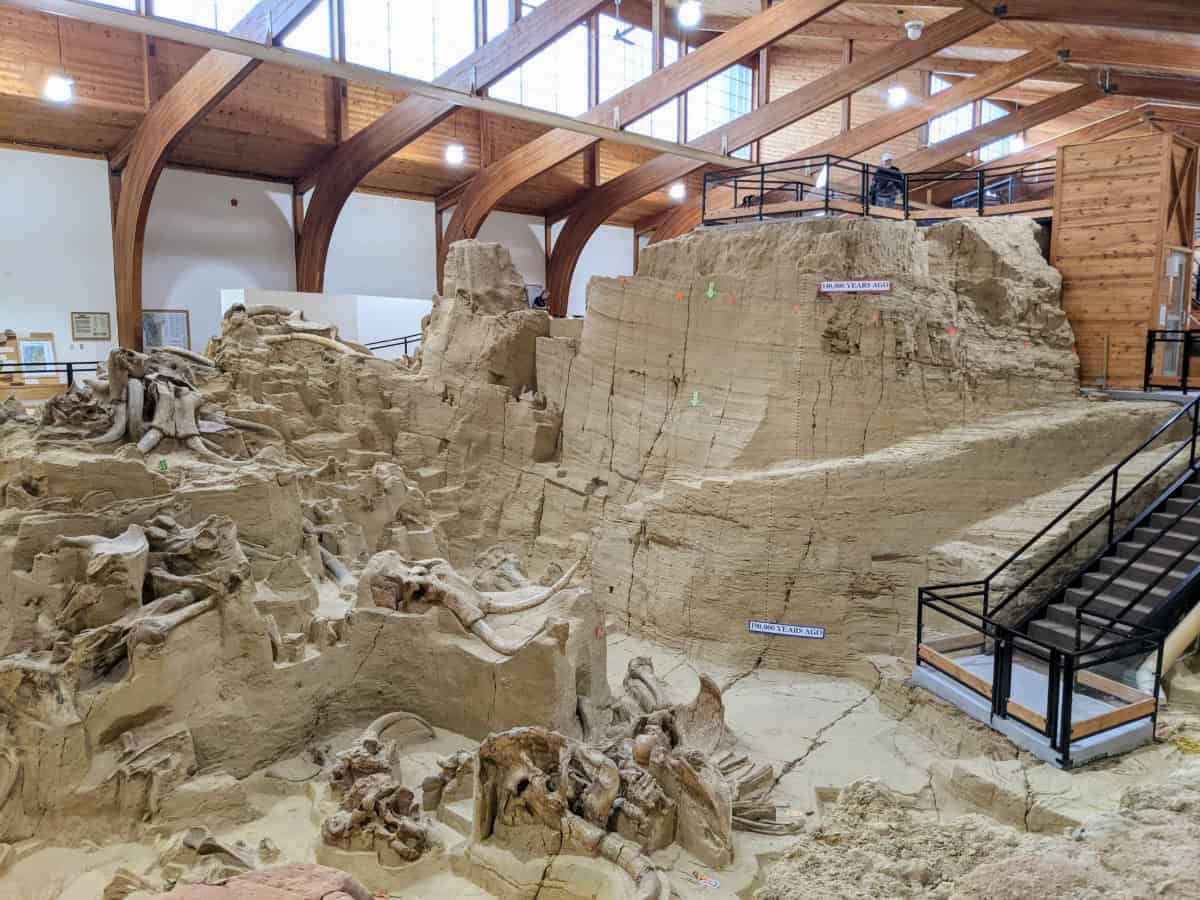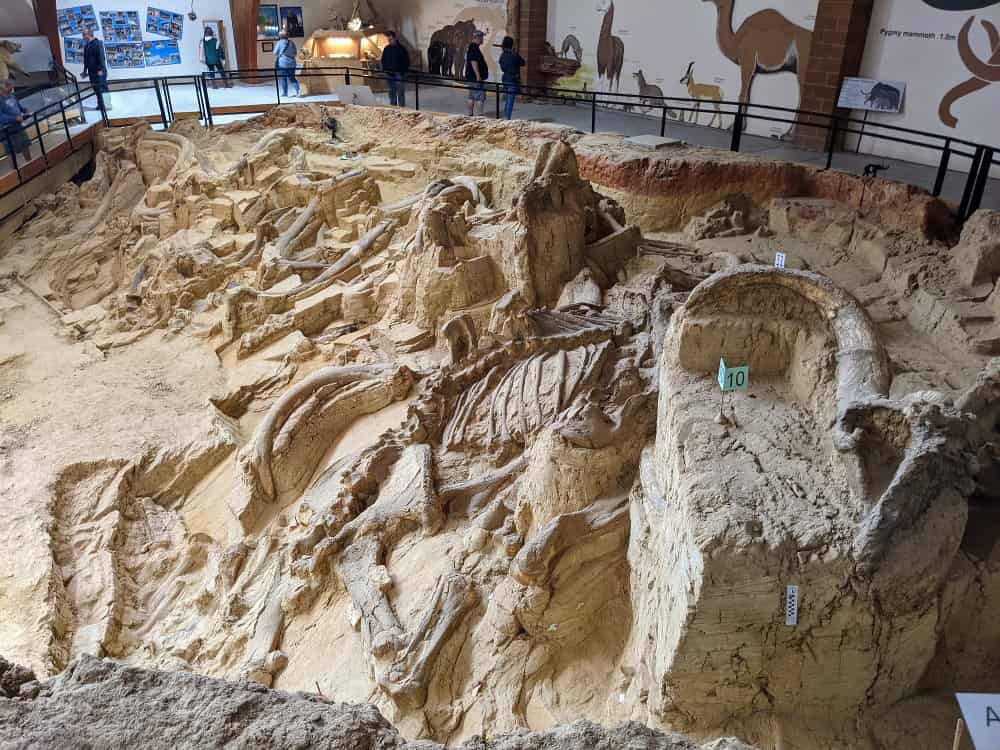So Many Mammoths In One Place At This Fun Museum
In Hot Springs, South Dakota lurks a wonderful little museum that deserves a place on any Black Hills vacation itinerary, especially if you have budding paleontologists in the family.
Or even if you have jaded teenagers, this compact museum will win them over with its impressive number of mammoth skeletons in one place (at least 60 so far have been found).
We found The Mammoth Site to be a unique museum that was educational and engaging for the whole family and absolutely worth the ticket price. Visiting The Mammoth Site was a nice change of pace for the kids from the steady stream of hiking and biking we did in the Black Hills, especially on the rainy day we visited.

Heads Up: This post may contain affiliate links, meaning we may get a commission if you make a purchase through our links, at no additional cost to you. We don’t do sponsored posts, free trips, or accept items for reviews. We only link to things we like and use personally. Read more about our philosophy.
What IS The Mammoth Site?
The world’s largest collection of mammoth bones in situ. The Mammoth Site is an Ice Age sinkhole that you can easily walk completely around and even take the catwalk over the top to see the skeletons in depth and how they are being excavated.
A Brief History Of How It Came To Be
There was a sinkhole in this spot 140,000 years ago, during one of the warmer periods of the Ice Ages. It must have looked very inviting with warm water and grass growing around the edges but the sinkhole had slippery shale lining its steep sides, making it very difficult to climb out of. The sinkhole was also surprisingly deep, about 60 feet in parts of it. All of this made for an excellent mammoth trap.
There are 2 kinds of mammoths buried here, the smaller woolly mammoth and the larger Columbian mammoth that was truly enormous in size. The majority of the remains are Columbian mammoths.
Over time, silt eventually filled in the sinkhole, burying the remains and preserving them. Silt turned to rock, which ensured the bones would still be around for us to find in great shape, thousands of years later.
In 1974, an excavator using a backhoe was clearing the site for a housing development and discovered the first tusk by accidentally scraping it (you can see that tusk on the tour and also in the picture below).
It took a while to figure out just how many bones were here, but eventually researchers realized this was a veritable treasure trove of Ice Age information.
There are other Ice Age flora and fauna remains also in the sinkhole, that were similarly trapped like the mammoths, or maybe died nearby and their remains were washed into the sinkhole.
The huge extinct short- nosed bear skeleton was a crowd favorite for the kids but you can also see much smaller species like clams and snails that are equally important in telling us about the environment that existed here during the Ice Ages. But the mammoths are really the star.

4 Reasons Why Visiting The Mammoth Site Should Be On Your Black Hills Itinerary
The Black Hills has an abundance of really cool things to see, making planning a week long trip there an exercise in narrowing down choices. So why do I think The Mammoth Site deserves a place on the list?
1. It Is Unique In The World
For all you bucket list people, The Mammoth Site has the largest amount of mammoth remains in situ (“in place”) in the world.
Unlike other museums that have collected mammoth remains from lots of different locations to exhibit, these bones are from mammoths that lived and died here.
2. It Doesn’t Take A Lot Of Time To Tour
The sinkhole itself isn’t huge so neither is the museum. It took us a little over an hour to see everything and I am a museum person and love to read all the signs. (I also make the kids read all the signs and they love it too, I swear.)
3. The Self-guided Tour Is Well Thought Out And Easy To Follow
I thought the walk around the site with its 9 stops was well organized and informative. “Points of interest” in the Bonebed (what they call the sinkhole site) were labelled clearly with flags and arrows and it was easy to follow along in the brochure.
I also liked the decent number of interactive elements in the museum. From the life size mural depicting how large mammoths really were (which the kids all wanted to measure themselves against) to the whole set up of the Bonebed itself with its catwalk over the top the excavation kept the kids and me engaged in learning in more ways than just reading information.
You could use QR codes on your phone, grab a free booklet, or just read the signs at each stop. Whatever works for you or your kids. Again, a nice touch to provide multiple ways to learn.
4. It Is Indoors
Works for hot days, cold days, rainy days, etc. Visiting The Mammoth Site makes for a nice change of pace from the otherwise mostly outdoor attractions in the Black Hills.

The Details Of Our Visit
Getting There
We arrived around 1130am on a rainy day in early October after visiting nearby Wind Cave National Park (about 20 min away).
The Mammoth Site is just outside the main strip of historic buildings of Hot Springs, South Dakota, which itself is located 50-60 min south of Rapid City and 40 min south of Custer.
I was surprised that the parking lot had a decent amount of cars since early October is the beginnings of the off season in the Black Hills but it was a Saturday. Still, the museum wasn’t crowded at all. I could see summer being a different issue though.
Entrance and Tickets
We parked and walked up to the front doors, stopping to look at the large rocks and signs taking you from the Precambrian Age, 2.5 billion years ago, up to the late Pleistocene, the age that the sinkhole occurred. I thought this was a neat way to decorate the pathway up from the parking lot and set the scene for your time travel back to the Ice Age.
We entered the museum, paid our entrance fee, and took a gander at the large replica woolly mammoth skeleton in the lobby. Woolly mammoths are the smaller of the 2 kinds of mammoths found in the sinkhole, the other kind being a Columbian mammoth.
We watched the 10 minute video first before going into the Bonebed. It was worth watching and tells you all about the Ice Age environment when the sinkhole was formed, as well as how the site is being excavated.
Walking Around The Bonebed
Once we entered the double doors into the active excavation site, we looked for Stop #1 which was a little away from the doors you enter.
It was nice to start there because this stop is about the formation of the sinkhole and how it was discovered but it is not absolutely necessary to start there if it is crowded. You can start anywhere and circle back around since the self- guided tour is a loop.
We then proceeded around the Bonebed in the order of the numbered stops. We looked for the little black mammoth icons marking each numbered stop on the path. Then we read the corresponding pages in our booklet.
You could read the sign at each stop as it had the same info as the booklet but it was nice that everybody could read the information without having to crowd around the sign. So definitely grab some booklets.
There are also QR codes to cue the audio tour through your cell phone if you brought your headphones. So lots of choices for people to do what’s best for them. I really liked that.
*There are other informational signs around the Bonebed besides the signs at the numbered stops so make sure to look out for them. They had info that wasn’t in the booklet or the QR codes.
It took us about 40 minutes to go around the Bonebed and read all the signs which was plenty for us. It wasn’t crowded at all, so I think it would have taken us longer if we had to wait on people to shuffle along in front of us.
One of the things I found very interesting was how easy it was to see the original layers of silt at the bottom of the sinkhole as the now distinct lines in the rock. You could clearly see where there had been disturbances in the silt, such as the giant mammoth footprints they point out.
The kids and I could readily picture the sinkhole as it was in the Ice Ages, like walking in a muddy pond or in the marshes of South Carolina.

Walking Around The Exhibit Hall
After we were done seeing the Bonebed, we walked thru the double doors into the Exhibit Hall which was small but had some nifty stuff.
There was a replica of a European mammoth bone house that you could go inside, replicas of mummified baby woolly mammoths that have been discovered elsewhere in the world, and lots of information about pygmy mammoths. These miniature mammoths were something I didn’t even know existed before my visit here and is now my favorite animal ever.
The kids were a little done by the time we got to the Exhibit Hall and hurried me through my newfound fascination with pygmy mammoths so we didn’t spend a ton of time here, just about 15 minutes. I wish I could have spent longer in the Exhibit Hall but hungry kids wait for no one.
Lunch Afterwards
We left The Mammoth Site around 1 pm and headed to Custer to find something to eat, about a 40 min drive. See below “Where To Eat”
If I planned it better and we were here in summer, I would absolutely pack a picnic and sign the kids up for an afternoon atlatl throwing lesson at the museum (more on that below too under “Other Activities”). I mean, how better to spend a summer afternoon than watching children throw spears at wooden cutouts of bison and mammoths?

Other Stuff You Might Want To Know
Hours (opens daily)
- March 1 – May 23: 9:00 am – 5:00 pm
- May 24 – August 24: 8:00 am – 6:00 p.m
- August 25 – October 31: 9:00 am – 5:00 pm
- November 1 – February 28: 9:00 am – 3:30 pm
Ticket Prices
- Children 3 & Under – Free
- Ages 4-12 – $12.00
- Ages 13-59 – $15.00
- Active & Retired Military – $13.00
- Ages 60 & Over – $13.00
Other Activities Offered At The Mammoth Site
There is a Kids Cave by the gift shop for small children. I saw an area for play digging for fossils that I know my kids would never want to leave when they were younger.
If you go downstairs, you can watch the scientists at work through the laboratory windows. We missed this and I only saw it was a possibility when I was looking at the brochure later.
There are additional classes you can sign up for but they are only offered in the summer. Book online ahead of time to make sure you get a spot or check the whiteboard when you arrive to see if there are any spots left that day:
- The Jr. Paleontology Program is extremely popular and teaches kids 4-12 how to dig for fossils. $11.06 per kid.
- The Family Dig program is basically the same idea as the Jr. Paleontology program except now parents can get dirty with their kids. $48 per family.
- Atlatl Throwing class is the one the kids were most upset to miss. You get to learn how to throw a spear using an atlatl, just like how early humans hunted mammoth and other large mammals. Ages 8 and up, $12 each.
You can buy a bag of dirt in the gift shop and take it to the sluice outside to pan for gemstones and fossils. Again, this wasn’t open when we were here in October but the kids would have loved this when they were younger.

Where To Eat Near The Mammoth Site
Hot Springs
If you didn’t bring a picnic, you can head around the corner from The Mammoth Site to the main street of Hot Springs. I really liked the historic buildings and the little greenway by the creek here. There aren’t a ton of restaurants in Hot Springs but there is enough tourist traffic to support a couple right in this part of town.
Although we did not actually eat here, the Upper Crust Bakery and Cafe was recommended to us (offers breakfast and lunch and has to go baked goods like donuts). There were also a couple of ice cream places we passed that looked good to the kids (they all look good to them though).
Custer
One of the larger towns in the area, Custer has quite a few restaurants on its main strip but it also has lots of tourists so there can be long wait lists in season. Maria’s Mexican, The Custer Wolf, and Horatio’s Homemade Ice Cream were some of our favorites in town.
Where to Stay Near The Mammoth Site
We found that Rapid City was more competitive price-wise than the smaller towns in the Black Hills so we stayed there some of the time.
This is a quick list of where we stayed but the blog has more:
We stayed two nights at the Holiday Inn Express Hill City- Mt Rushmore and it was great. There was also a Holiday Inn Express in Custer that we looked at as well, it also had a good location, included breakfast, and nice- sized rooms.
We also stayed two nights in Rapid City at the Residence Inn in Rapid City. I would stay here again as well and particularly like the 2 BR/ 2 BA suites for giving the family plenty of room.
We looked at these vacation rentals below but couldn’t get the availability to work out with all that we wanted to do on our trip.
Peaceful, Private Log Home With Exceptional Views And Amenities is a large 4 BR/ 2.5 BA log cabin set on a secluded hillside in a pine forest with gorgeous views.
Spacious Home- Centrally Located In The Black Hills- Hot Tub, ATV is a very large 4BR/ 3.5BA home that comes with a hot tub, bikes for the nearby Mickelson Trail, and an ATV.
Final Thoughts
The whole family thought The Mammoth Site was an interesting and unusual museum. (I can honestly say it is the one and only sinkhole filled with mammoth bones that I have ever visited). I also liked that it only took us a little over an hour total to visit, which made it easy to pencil into our itinerary when we found ourselves with some time.
We dropped by The Mammoth Site from nearby Wind Cave National Park, as rainy weather changed our afternoon hiking plans. Being indoors, I could also see it being a welcome change up after outdoor activities in the hot summer too.
Happy Trails! – Amanda
















